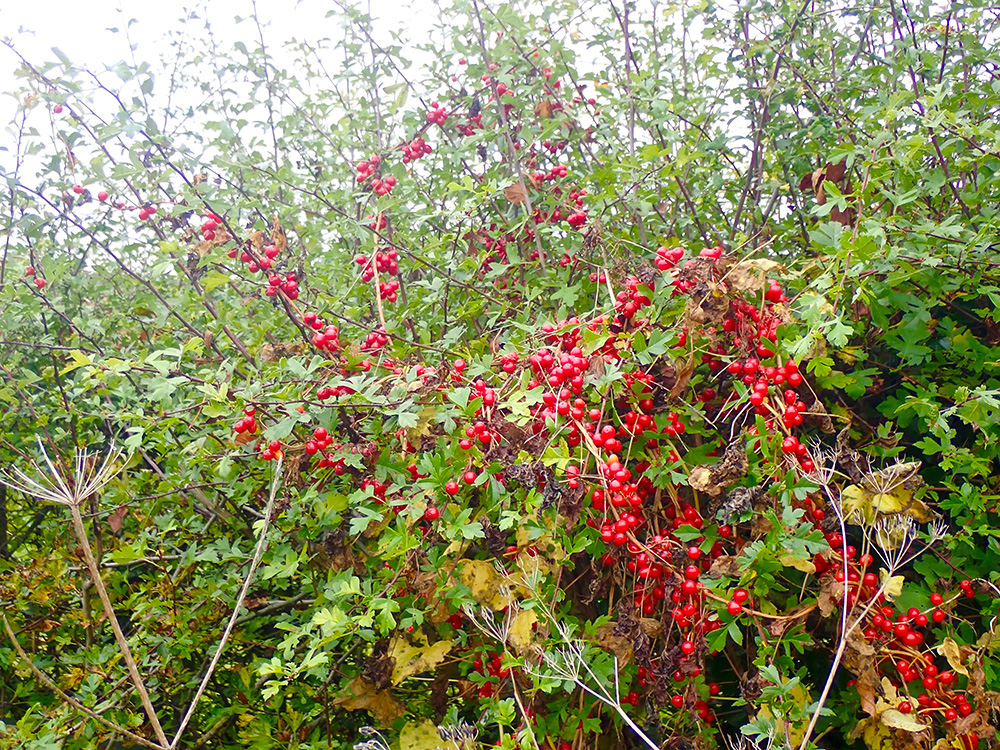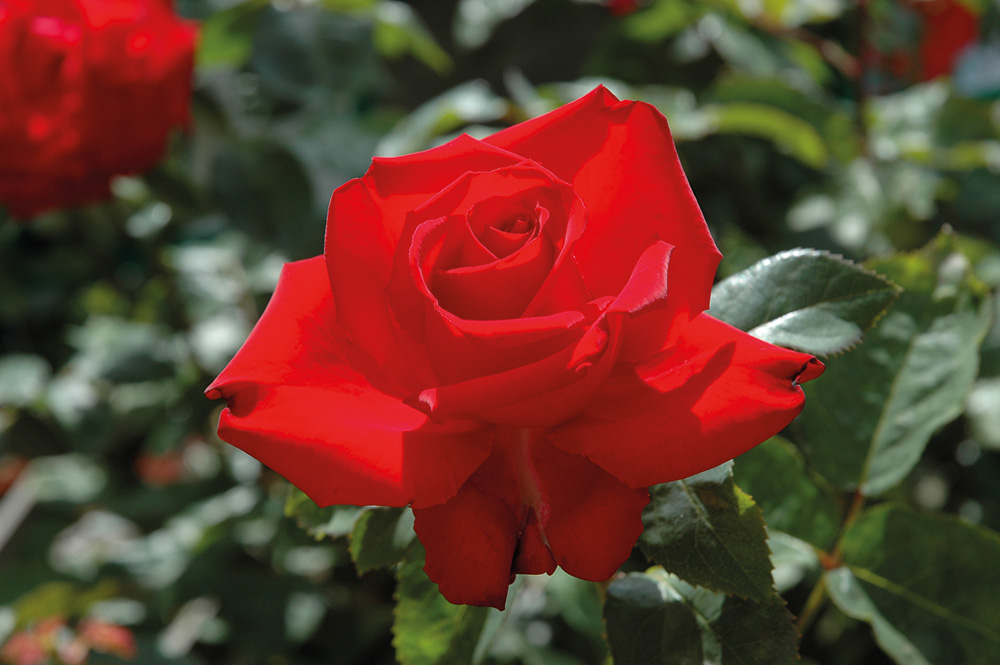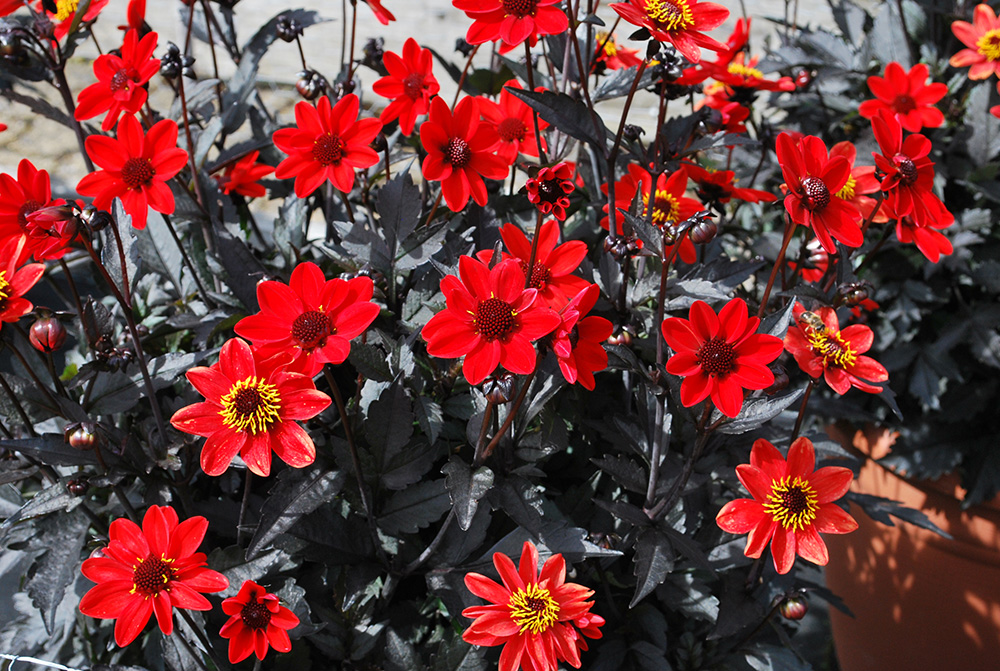At this time of year, as summer gives way to autumn, there are glimmers of bright red beginning to appear. The string of black bryony berries, winding their way over the hedges down the lane, are as gaudy as Edna Everage’s highly lacquered spectacles. Tamus communis, our only native member of the yam family, is highly poisonous to livestock. Many stock farmers try to eradicate it before it produces any tempting yam-like fleshy roots. The birds, willing consumers of the berries, thwart the entire process by spreading the seeds about from year to year. You’ll also see white bryony, Bryonia dioica in the hedges. This cucurbit has long tendrils and red berries said to ripen to black, although I have never seen this. The berries are equally poisonous. Forty berries could kill a human. But don’t try that at home folks!
Painters (though not the decorating kind) often deploy a splash of red, because it brings their paintings to life. There is one very famous anecdote about J.M.W. Turner and John Constable, dating back to the Royal Academy’s Summer Exhibition of 1832. These two prominent painters were chalk and cheese in every respect. The eccentric Turner, born in London’s Covent Garden in 1775, came from a lower middle-class family and preserved his London accent for the rest of his life. He made money from a young age and left a small fortune and a huge legacy of paintings and sketchbooks to The National Gallery.
John Constable, although the son of a wealthy Suffolk merchant and miller, died a relatively poor man having sold only twenty paintings in Britain during his lifetime. The Hay Wain failed to find a buyer in 1821, so it was shipped to France, whereupon it got a Gold Medal and a royal seal of approval from Charles X of France. It was bought in Paris, before coming back here.

c. Val Bourne
The two landscape artists were at opposite ends of the artistic spectrum as well. Constable’s style was rustic and extremely detailed. Turner’s painting style was subdued and a forerunner of the Impressionist movement. This was very evident in his moody seascape, Helvoetsluys. Those moody skies were the result of volcanic activity, following the eruption of the Tambora volcano in Indonesia in 1815. More eruptions followed. Trouble bubbled over, rather like the lava, after Turner’s painting was re-positioned at the very last moment by John Constable – the Royal Society’s so-called ‘hangman’. He was in charge of staging the Summer Exhibition of 1832. Constable placed his own painting, The Opening of Waterloo Bridge, in a more prominent position, just before the exhibition opened.
The less-than-pleased Turner responded by coming in with a tiny pot of red paint and adding a small buoy to the rolling waves – bringing the picture to life. John Constable declared “he has been here and fired a gun.” The two pictures were recently reunited by the Royal Academy in their Collection Gallery in 2019. It’s a good thing these eminent artists are not lying side by side in St Paul’s Cathedral, Turner’s last resting place. Constable is buried in the churchyard of St John in Hampstead.
Red has the same dynamic effect in the garden and I discovered this quite by accident, without any firearms (metaphorical or not) being involved. I planted a potful of twenty burgundy-red tulips called ‘National Velvet’ some thirty years ago. It brought a semi-shaded area of my garden to life in a remarkable way. ‘National Velvet’ is a Triumph tulip and these thicker petalled tulips with shorter stems flower in the second half of April. They have been bred for the cut-flower trade so there are plenty to choose from. They should always be the main ingredient in your tulip recipe, along with some taller May-flowering single tulips and then you’ll get a four-week long display. I think ‘National Velvet’, a deep-red with black overtones, looks best planted on its own. Good Triumph varieties include ‘Slawa’, a deep-maroon and orange’, and the bright-purple ‘Negrita’. Although I wouldn’t pair them together!
A pot of red pelargoniums will create the same kind of magic in summer and a red rose can have the same magical effect. Disease-free red roses are few and far between. Most are weak growers and they tend to suffer from disfiguring black spot. With this in mind, the RHS staged a trial of sixty Red Roses in 2024, but gave just four new AGMs. ‘Red Finesse’, ‘Moment in Time’ and ‘My Valentine’ are all bred by Kordes, a German rose company known for breeding disease-free roses.

c. Peter Beales
‘My Valentine’ (‘Korcoluma’) is a shorter repeat-flowering fragrant deep-red hybrid tea introduced in 2004. Hybrid teas have scrolled buds and stems with one to three flowers. ‘Red Finesse’ (‘’Korvillade), released in 2001, is a floribunda bearing clusters of lightly scented flowers. ‘Moment in Time’(Korkastrav’) is another Kordes floribunda reaching 60cm or 2 feet. Floribunda roses can have up to twenty blooms per stems so they are very floriferous, although not very scented. Peter Beales Roses stock ‘My Valentine’ and ‘Moment in Time’.
You can always identify a Kordes rose if you look at the name in brackets, because it always starts with the letters Kor. This is the breeding name and it’s needed because roses are given different names in different countries. My all-time favourite rose, ‘Champagne Moment’ (‘Korvanaber’) was christened ‘The Lion’s Rose’ in America.
‘Eternity’ (‘Noa150097’), bred by Noack Roses, is another shorter semi-double floribunda, named because it flowers on and on. Noack is another German rose company, most well known for their Flower Carpet Series of groundcover roses. German rose breeders concentrate on disease resistance and, I’m delighted to say that British rose breeders are following suit. ‘Eternity’ seems to pop up in garden centres.
Any of these four red roses could be grown in a large winter-proof container, but with one proviso. Pot-grown roses need more food and regular watering to perform well. They are more high-maintenance, although worth the effort. Feed them with Vitax Q4, a high potash feed that’s cheaper than rose food, and water them well in the growing season. Find a bright position and use pot feet in winter, to aid drainage. Repot every other spring, or sooner if the rose appears to be losing vigour.

C. Val Bourne
You could also grow a red dahlia, for a pop of colour, and my top choice is still ‘Bishop of Llandaff’, despite it being raised by Fred Treseder in 1922. The semi-double flowers are a rich-red and they’re held on slender black stems above almost-black ferny foliage. The great thing about this centenarian dahlia is its ability to survive and thrive in all weathers, regardless of how the summer is. The fact that this centenarian has never succumbed to virus, is a testament to its worth. I often have a pot of ‘Pulp Fiction’ in the garden as well.
Dahlias need support, but I am not keen on canes. They’re time consuming to place (and you need three for each dahlia and caps for each cane) and they look unsightly. Years ago, I saw several plants of The Bishop supported by the willowy, yet robust, stems of Verbena bonariensis. The combination of purple and bright clarion-red inspired me to support my dahlias with strong-stemmed colourful plants.
Annual cosmos works well, but I have also used gladioli amongst them as well. I guess that’s also Dame Edna inspired, but gladioli are underused in gardens. This year my dahlias have struggled. They were planted out in May and never got going – due to the lack of rain. September may revive them. Perhaps, or perhaps not, we shall see.



